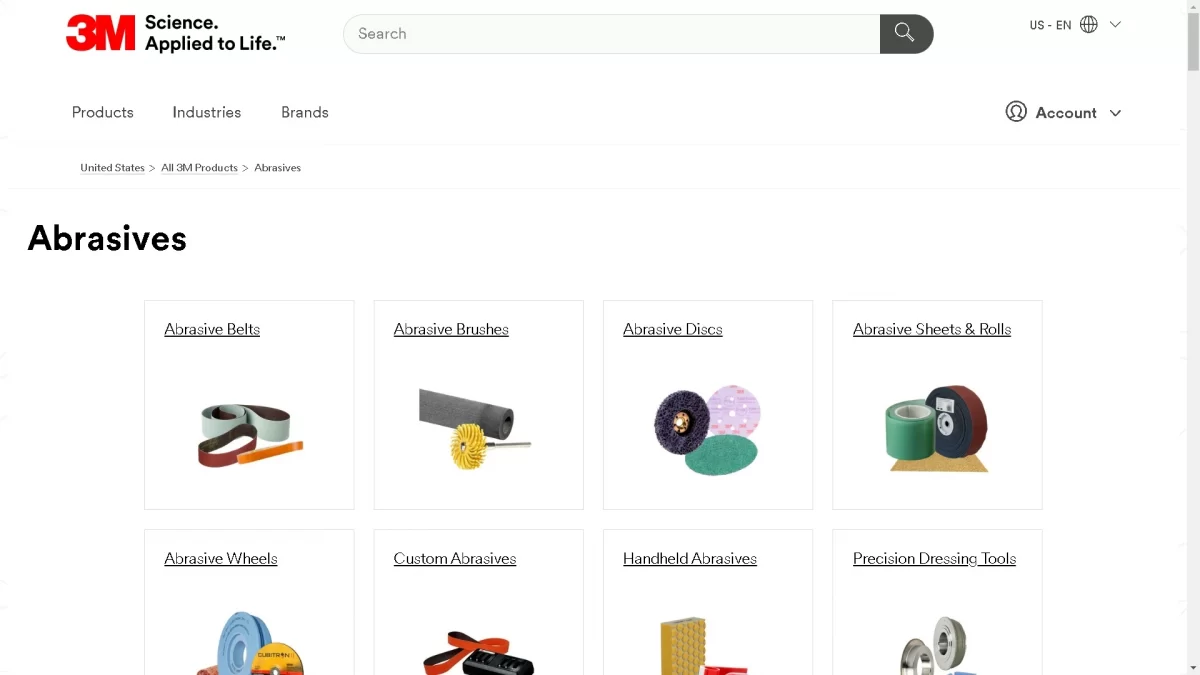3M Abrasives: If you’re in the market for abrasives, 3M is a brand that has likely caught your attention. With a vast selection of abrasive products that cater to diverse industries and applications, 3M has established itself as a leading manufacturer of abrasives worldwide. This guide aims to provide an in-depth overview of 3M abrasives, their features, applications, and advantages. From sanding to grinding, we’ve got you covered.
In this guide, we will discuss
- What are Abrasives?
- Understanding Abrasive Grits
- Types of Abrasives
- Bonded Abrasives
- Coated Abrasives
- Non-woven Abrasives
- Superabrasives
- Applications of Abrasives
- Woodworking
- Metalworking
- Automotive Industry
- Aerospace Industry
- Electronics
- Construction Industry
- Benefits of Using 3M Abrasives
- Consistent Finish
- Extended Durability
- Reduced Downtime
- Improved Productivity
- Safe and Clean Working Environment
- How to Choose the Right Abrasive
- Material to be worked on
- Grit size
- Type of abrasive
- How to Use Abrasives Safely
- PPE (Personal Protective Equipment)
- Handling and Storage
- Precautions During Use
- Maintenance and Storage of Abrasives
- Conclusion
- FAQs
1. What are Abrasives?
Abrasives are materials used for grinding, cutting, polishing, or sanding surfaces. They are essential tools in various industries, including woodworking, metalworking, automotive, aerospace, and electronics. Abrasives can be natural or synthetic and come in various forms, including grains, powders, and compounds. They are characterized by their abrasive grits, which determine their aggressiveness and coarseness.
2. Understanding Abrasive Grits
Abrasive grits are the tiny particles that make up an abrasive. They can be made from a wide range of materials, including diamonds, ceramics, aluminum oxide, silicon carbide, and zirconia. The grit size is an important factor that determines how abrasive the material is. It is measured in microns or mesh and indicates the number of particles per inch. The lower the number, the coarser the abrasive, while the higher the number, the finer the abrasive.
3. Types of Abrasives
There are four main types of abrasives: bonded, coated, non-woven, and superabrasives. Each type has unique properties that make it suitable for specific applications.
Bonded Abrasives
Bonded abrasives consist of abrasive grains that are bonded together using a binder material. They come in various forms, including grinding wheels, cut-off wheels, and honing stones. Bonded abrasives are ideal for heavy-duty grinding and cutting operations.
Coated Abrasives
Coated abrasives have abrasive grains coated on a flexible backing material, such as paper, cloth, or polyester. They are commonly used for sanding and finishing operations and come in different forms, including belts, discs, and sheets.
Non-woven Abrasives
Non-woven abrasives are made of nylon fibers that are impregnated with abrasive grains and bonded together using resin. They are commonly used for surface finishing and polishing operations and come in different forms, including discs, wheels, and belts.
Superabrasives
Superabrasives are made of diamond or
cubic boron nitride (CBN) and are the hardest and most aggressive abrasives. They are commonly used for grinding and cutting hard materials such as ceramics, glass, and hardened steel.
4. Applications of Abrasives
Abrasives are used in various industries for a wide range of applications. Here are some of the most common applications:
Woodworking
Abrasives are used in woodworking for sanding and finishing operations. They help to smooth out surfaces, remove imperfections, and prepare the wood for painting or staining.
Metalworking
Abrasives are used in metalworking for cutting, grinding, and polishing operations. They help to remove burrs, welds, and other imperfections, and produce a smooth and even surface.
Automotive Industry
Abrasives are used in the automotive industry for various applications, including sanding, grinding, and polishing. They help to prepare the surface for painting, remove rust, and shape and smooth out body panels.
Aerospace Industry
Abrasives are used in the aerospace industry for various applications, including cutting, grinding, and polishing. They help to shape and smooth out parts and components, remove imperfections, and prepare the surface for painting or coating.
Electronics
Abrasives are used in the electronics industry for various applications, including cutting, grinding, and polishing. They help to shape and smooth out parts and components, remove imperfections, and prepare the surface for coating or bonding.
Construction Industry
Abrasives are used in the construction industry for various applications, including cutting, grinding, and polishing. They help to shape and smooth out surfaces, remove imperfections, and prepare the surface for painting or coating.
5. Benefits of Using 3M Abrasives
3M abrasives offer several benefits that make them a preferred choice for many industries. Here are some of the benefits:
Consistent Finish
3M abrasives are engineered to provide a consistent finish, ensuring that the surface is smooth and even.
Extended Durability
3M abrasives are designed to last longer, reducing downtime and increasing productivity.
Reduced Downtime
3M abrasives are designed to minimize downtime, ensuring that the work is completed quickly and efficiently.
Improved Productivity
3M abrasives are designed to improve productivity, helping workers complete tasks quickly and efficiently.
Safe and Clean Working Environment
3M abrasives are designed to provide a safe and clean working environment, reducing the risk of accidents and injuries.
6. How to Choose the Right Abrasive
Choosing the right abrasive depends on several factors, including the material to be worked on, the grit size, and the type of abrasive. Here are some tips to help you choose the right abrasive:
Material to be worked on
Different materials require different abrasives. For example, wood requires a different abrasive than metal. Consider the material to be worked on when choosing an abrasive.
Grit size
Choose the appropriate grit size based on the aggressiveness of the material. Coarse grits are more aggressive, while fine grits are less aggressive.
Type of abrasive
Choose the right type of abrasive based on the application. Bonded abrasives are ideal for heavy-duty grinding and cutting operations, while coated abrasives are ideal for sanding and finishing operations.
7. How to Use Abrasives Safely
Using abrasives can be dangerous if proper precautions are not taken. Here are some tips to help you use abrasives safely:
PPE (Personal Protective Equipment)
Wear appropriate PPE, such as eye protection, gloves, and a dust mask, to protect yourself from flying debris.
Proper Tool Inspection
Inspect the abrasive tool before use, checking for cracks, defects, and wear. Discard any damaged or worn-out tools.
Proper Use of Tools
Use the abrasive tool at the recommended speed and pressure, avoiding excessive force or pressure that can cause the tool to break or shatter.
Proper Storage of Tools
Store abrasive tools in a dry and secure location, away from moisture and extreme temperatures.
8. Conclusion
In conclusion, abrasives play a crucial role in various industries, including woodworking, metalworking, automotive, aerospace, electronics, and construction. 3M abrasives are a preferred choice for many industries due to their consistent finish, extended durability, reduced downtime, improved productivity, and safe working environment. When choosing an abrasive, consider the material to be worked on, grit size, and type of abrasive. To use abrasives safely, wear appropriate PPE, inspect tools before use, use tools properly, and store tools correctly.
FAQs
- What is an abrasive?
An abrasive is a material used for cutting, grinding, or polishing a workpiece.
- What are the types of abrasives?
The types of abrasives include bonded abrasives, coated abrasives, and superabrasives.
- What are the applications of abrasives?
Abrasives are used in various industries, including woodworking, metalworking, automotive, aerospace, electronics, and construction.
- What are the benefits of using 3M abrasives?
The benefits of using 3M abrasives include consistent finish, extended durability, reduced downtime, improved productivity, and safe working environment.
- How do you use abrasives safely?
To use abrasives safely, wear appropriate PPE, inspect tools before use, use tools properly, and store tools correctly.


